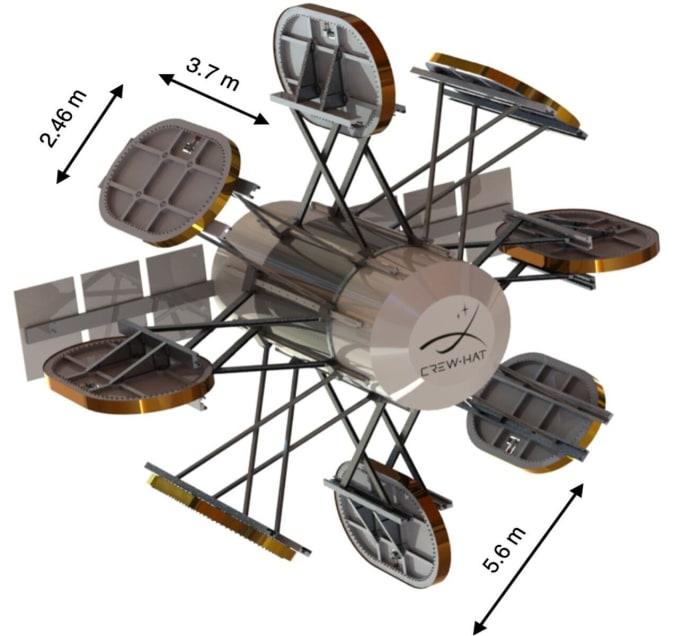General
How NASA might protect tomorrow’s astronauts from deep space radiation

The first Mars explorers might make the trip wrapped in a protective electromagnetic bubble.
There are a million and one ways to die in space, whether it’s from micrometeoroid impacts shredding your ship or solar flares frying its electronics, drowning in your own sweat during a spacewalk or having a cracked coworker push you out an airlock. And right at the top of the list is death by radiation.
Those same energetic emissions from our local star that give you a tan can scour the atmosphere from a planet if it doesn’t enjoy the protection of an ozone layer. While today’s low Earth orbit crew and cargo capsules may not come equipped with miniature magnetospheres of their own, tomorrow’s might — or maybe we’ll just protect humanity’s first deep space explorers from interstellar radiation by ensconcing them safely in their own poop.
Types of Radiation and what to do about them
Like strokes and folks, there are different types and sources of radiation both terrestrial and in space. Non-ionizing radiation, meaning the atom doesn’t have enough energy to fully remove an electron from its orbit, can be found in microwaves, light bulbs, and Solar Energetic Particles (SEP) like visible and ultraviolet light. While these forms of radiation can damage materials and biological systems, their effects can typically be blocked (hence sunscreen and microwaves that don’t irradiate entire kitchens) or screened by the Ozone layer or Earth’s magnetosphere.

Earth’s radiation belts are filled with energetic particles trapped by Earth’s magnetic field that can wreak havoc with electronics we send to space. Credits: NASA’s Scientific Visualization Studio/Tom Bridgman
Ionizing radiation, on the other hand, is energetic to shed an electron and there isn’t much that can slow their positively-charged momentum. Alpha and beta particles, Gamma rays, X-rays and Galactic Cosmic Rays, “heavy, high-energy ions of elements that have had all their electrons stripped away as they journeyed through the galaxy at nearly the speed of light,” per NASA. “GCR are a dominant source of radiation that must be dealt with aboard current spacecraft and future space missions within our solar system.” GCR intensity is inversely proportional to the relative strength of the Sun’s magnetic field, meaning that they are strongest when the Sun’s field is at its weakest and least able to deflect them.

Chancellor, J., Scott, G., & Sutton, J. (2014)
Despite their dissimilar natures, both GCR and SEP damage the materials designed to shield our squishy biological bodies from radiation along with our biological bodies themselves. Their continued bombardment has a cumulative negative effect on human physiology resulting not just in cancer but cataracts, neurological damage, germline mutations, and acute radiation sickness if the dose is high enough. For materials, high-energy particles and photons can cause “temporary damage or permanent failure of spacecraft materials or devices,” Zicai Shen of the Beijing Institute of Spacecraft Environment Engineering notes in 2019’s Protection of Materials from Space Radiation Environments on Spacecraft.
“Charged particles gradually lose energy as they pass through the material, and finally, capture a sufficient number of electrons to stop,” they added. “When the thickness of the shielding material is greater than the range of a charged particle in the material, the incident particles will be blocked in the material.”
How NASA currently protects its astronauts
To ensure that tomorrow’s astronauts arrive at Mars with all of their teeth and fingernails intact, NASA has spent nearly four decades collecting data and studying the effects radiation has on the human body. The agency’s Space Radiation Analysis Group (SRAG) at Johnson Space Center is, according to its website, “responsible for ensuring that the radiation exposure received by astronauts remains below established safety limits.”
According to NASA, “the typical average dose for a person is about 360 mrems per year, or 3.6 mSv, which is a small dose. However, International Standards allow exposure to as much as 5,000 mrems (50 mSv) a year for those who work with and around radioactive material. For spaceflight, the limit is higher. The NASA limit for radiation exposure in low-Earth orbit is 50 mSv/year, or 50 rem/year.”
SRAG’s Space Environment Officers (SEOs) are tasked with ensuring that the astronauts can successfully complete their mission without absorbing too many RADs. They take into account the various environmental and situational factors present during a spaceflight — whether the astronauts are in LEO or on the lunar surface, whether they stay in the spacecraft or take a spacewalk, or whether there is a solar storm going on — combine and model that information with data collected from onboard and remote radiation detectors as well as the NOAA space weather prediction center, to make their decisions.
The Radiation Effects and Analysis Group at Goddard Space Flight Center, serves much the same purpose as SRAG but for mechanical systems, working to develop more effective shielding and more robust materials for use in orbit.
“We will be able to ensure that humans, electronics, spacecraft and instruments — anything we are actually sending into space — will survive in the environment we are putting it in,” Megan Casey, an aerospace engineer in the REAG said in a 2019 release. “Based on where they’re going, we tell mission designers what their space environment will be like, and they come back to us with their instrument plans and ask, ‘Are these parts going to survive there?’ The answer is always yes, no, or I don’t know. If we don’t know, that’s when we do additional testing. That’s the vast majority of our job.”
NASA’s research will continue and expand throughout the upcoming Artemis mission era. During test flights for the Artemis I mission, both the SLS rocket and the Orion spacecraft will be outfitted with sensors measuring radiation levels in deep space beyond the moon — specifically looking at the differences in relative levels beyond the Earth’s Van Allen Belts. Data collected and lessons learned from these initial uncrewed flights will help NASA engineers build better, more protective spacecraft in the future.
And once it does eventually get built, crews aboard the Lunar Gateway will maintain an expansive radiation sensor suite, including the Internal Dosimeter Array, designed to carefully and continually measure levels within the station as it makes its week-long oblong orbit around the moon.
“Understanding the effects of the radiation environment is not only critical for awareness of the environment where astronauts will live in the vicinity of the Moon, but it will also provide important data that can be used as NASA prepares for even greater endeavors, like sending the first humans to Mars,” Dina Contella, manager for Gateway Mission Integration and Utilization, said in a 2021 release.
NASA might use magnetic bubbles in the future
Tomorrow’s treks into interplanetary space, where GCR and SEP are more prevalent, are going to require more comprehensive protection than the current state of the art passive shielding materials and space weather forecasting predictions can deliver. And since the Earth’s own magnetosphere has proven so handy, researchers with the European Commission’s Community Research and Development Information Service (CORDIS) have researched creating one small enough to fit on a spaceship, dubbed the Space Radiation Superconducting Shield (SR2S).
The €2.7 million SR2S program, which ran from 2013 to 2015, expanded on the idea of using superconducting magnets to generate a radiation-stopping magnetic force field first devised by ex-Nazi aerospace engineer Wernher von Braun in 1969. The magnetic field produced would be more than 3,000 times more concentrated than the one encircling the Earth and would extend out in a 10-meter sphere.
“In the framework of the project, we will test, in the coming months, a racetrack coil wound with an MgB2 superconducting tape,” Bernardo Bordini, coordinator of CERN activity in the framework of the SR2S project, said in 2015. “The prototype coil is designed to quantify the effectiveness of the superconducting magnetic shielding technology.”
It wouldn’t block all incoming radiation, but would efficiently screen out the most damaging types, like GCR, which flows through passive shielding like water through a colander. By lowering the rate at which astronauts are exposed to radiation, they’ll be able to serve on more and longer duration missions before hitting NASA’s lifetime exposure limit.
“As the magnetosphere deflects cosmic rays directed toward the earth, the magnetic field generated by a superconducting magnet surrounding the spacecraft would protect the crew,” Dr Riccardo Musenich, scientific and technical manager for the project, told Horizon in 2014. “SR2S is the first project which not only investigates the principles and the scientific problems (of magnetic shielding), but it also faces the complex issues in engineering.”
Two superconducting coils have already been constructed and tested, showing the feasibility in using them to build lightweight magnets but this is very preliminary research, mind you. The CORDIS team doesn’t anticipate this tech making it into space for another couple decades.
Researchers from University of Wisconsin–Madison’s Department of Astronomy have recently set about developing their own version of CORDIS’ idea. Their Cosmic Radiation Extended Warding using the Halbach Torus (CREW HaT) project, which received prototyping funding from NASA’s Innovative Advanced Concepts (NIAC) program in February, uses “new superconductive tape technology, a deployable design, and a new configuration for a magnetic field that hasn’t been explored before,” according to UWM associate professor and researches lead author, Dr. Elena D’Onghia told Universe Today in May.

“The HaT geometry has never been explored before in this context or studied in combination with modern superconductive tapes,” she said in February’s NIAC summary. “It diverts over 50 percent of the biology-damaging cosmic rays (protons below 1 GeV) and higher energy high-Z ions. This is sufficient to reduce the radiation dose absorbed by astronauts to a level that is less than 5 percent of the lifetime excess risk of cancer mortality levels established by NASA.”
Or astronauts might wear leaden vests to protect their privates
But why go through the effort of magnetically encapsulating an entire spaceship when really it’s just a handful of torsos and heads that actually need the protection? That’s the idea behind the Matroshka AstroRad Radiation Experiment (MARE).
Developed in partnership with both the Israel Space Agency (ISA) and the German Aerospace Center (DLR), two of the MARE vests will be strapped aboard identical mannequins and launched into space aboard the Orion uncrewed moon mission. On their three-week flight, the mannequins, named Helga and Zohar, will travel some 280,000 miles from Earth and thousands of miles past the moon. Their innards are designed to mimic human bones and soft tissue, enabling researchers to measure the specific radiation doses they receive.
Its sibling study aboard the ISS, the Comfort and Human Factors AstroRad Radiation Garment Evaluation (CHARGE), focuses less on the vest’s anti-rad effectiveness and more on the ergonomics, fit and feel of it as astronauts go about their daily duties. The European Space Agency is also investigating garment-based radiation shielding with the FLARE suit, an “emergency device that aims to protect astronauts from intense solar radiation when traveling out of the magnetosphere on future Deep Space missions.”
Or we’ll line the ship hulls with water and poo!
One happy medium between the close-in discomfort of wearing a leaded apron in microgravity and the existential worry of potentially having your synapses scrambled by a powerful electromagnet is known as Water Wall technology.
“Nature uses no compressors, evaporators, lithium hydroxide canisters, oxygen candles, or urine processors,” Marc M. Cohen Arch.D, argued in the 2013 paper Water Walls Architecture: Massively Redundant and Highly Reliable Life Support for Long Duration Exploration Missions. “For very long-term operation — as in an interplanetary spacecraft, space station, or lunar/planetary base — these active electro-mechanical systems tend to be failure-prone because the continuous duty cycles make maintenance difficult.”
So, rather than rely on heavy and complicated mechanizations to process the waste materials that astronauts emit during a mission, this system utilizes osmosis bags that mimic nature’s own passive means of purifying water. In addition to treating gray and black water, these bags could also be adapted to scrub CO2 from the air, grow algae for food and fuel, and can be lined against the inner hull of a spacecraft to provide superior passive shielding against high energy particles.
“Water is better than metals for [radiation] protection,” Marco Durante of the Technical University of Darmstadt in Germany, told New Scientist in 2013. This is because the three-atom nucleus of a water molecule contains more mass than a metal atom and therefore is more effective at blocking GCR and other high energy rays, he continued.
The crew aboard the proposed Inspiration Mars mission, which would have slingshot a pair of private astronauts around Mars in a spectacular flyby while the two planets were at their orbital closest in 2018. You haven’t heard anything about that because the nonprofit behind it quietly went under in 2015. But had they somehow pulled off that feat, the plan was to have the astronauts poop into bags, sophon out the liquid for reuse and then pile the vacuum-sealed shitbricks against the walls of the spacecraft — alongside their boxes of food — to act as radiation insulation.
“It’s a little queasy sounding, but there’s no place for that material to go, and it makes great radiation shielding,” Taber MacCallum, a member of the nonprofit funded by Dennis Tito, told New Scientist. “Food is going to be stored all around the walls of the spacecraft, because food is good radiation shielding.” It’s just a quick jaunt to the next planet over, who needs plumbing and sustenance?

-

 Technology2 years ago
Technology2 years agoVoIP Number: Everything You Need To Know
-

 Music2 months ago
Music2 months ago[Music] Gnash Ft Olivia O’Brien – I Hate you, I Love you
-

 Music2 months ago
Music2 months ago[INSTRUMENTAL] John Legend – All Of Me
-

 Music2 months ago
Music2 months agoAlan Walker – Faded [INSTRUMENTAL]
-

 Music2 months ago
Music2 months ago[Video] 21 Savage ft. Offset & Metro Boomin – Rap Saved Me
-

 Music2 months ago
Music2 months ago[Instrumental] Wiz Khalifa – See You Again ft. Charlie Puth
-

 ANE Stories4 months ago
ANE Stories4 months ago[STORY] AMAKA THE LESBIAN (Complete Episodes)
-

 Music2 months ago
Music2 months ago[Music] Akon – Sorry Blame It On Me






























